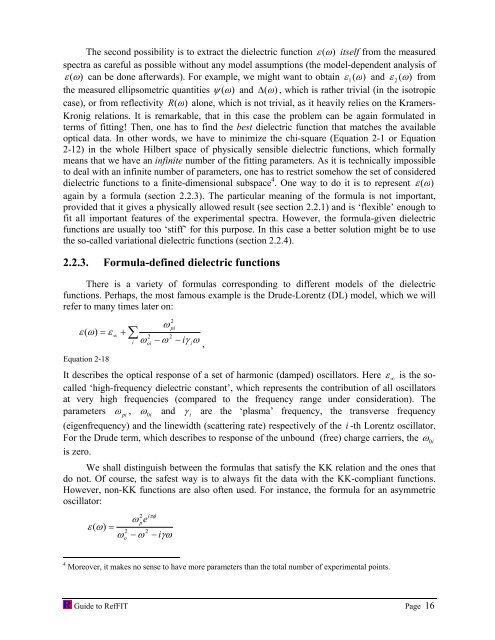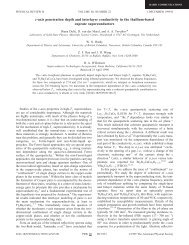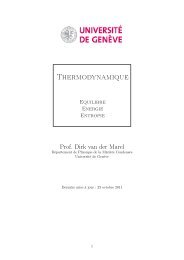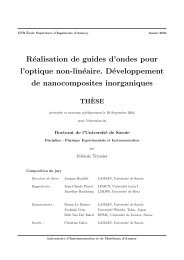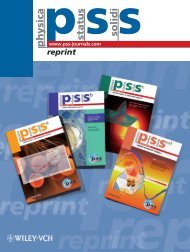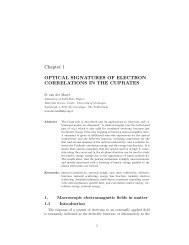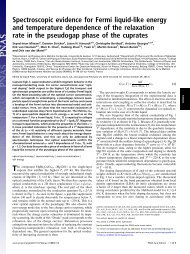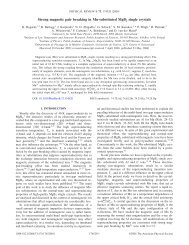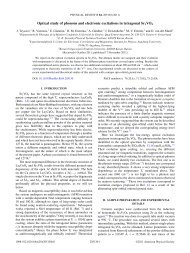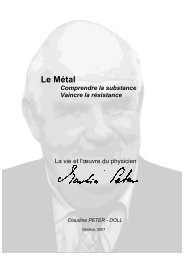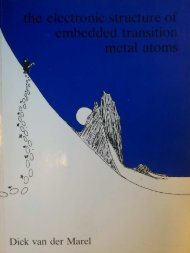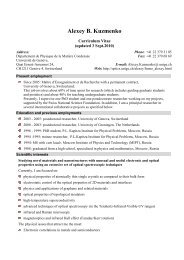software to fit optical spectra - Quantum Materials Group
software to fit optical spectra - Quantum Materials Group
software to fit optical spectra - Quantum Materials Group
You also want an ePaper? Increase the reach of your titles
YUMPU automatically turns print PDFs into web optimized ePapers that Google loves.
The second possibility is <strong>to</strong> extract the dielectric function ε (ω)<br />
itself from the measured<br />
<strong>spectra</strong> as careful as possible without any model assumptions (the model-dependent analysis of<br />
ε (ω)<br />
can be done afterwards). For example, we might want <strong>to</strong> obtain ε 1( ω)<br />
and ε 2 ( ω)<br />
from<br />
the measured ellipsometric quantities ψ (ω)<br />
and ∆ (ω)<br />
, which is rather trivial (in the isotropic<br />
case), or from reflectivity R (ω)<br />
alone, which is not trivial, as it heavily relies on the Kramers-<br />
Kronig relations. It is remarkable, that in this case the problem can be again formulated in<br />
terms of <strong>fit</strong>ting! Then, one has <strong>to</strong> find the best dielectric function that matches the available<br />
<strong>optical</strong> data. In other words, we have <strong>to</strong> minimize the chi-square (Equation 2-1 or Equation<br />
2-12) in the whole Hilbert space of physically sensible dielectric functions, which formally<br />
means that we have an infinite number of the <strong>fit</strong>ting parameters. As it is technically impossible<br />
<strong>to</strong> deal with an infinite number of parameters, one has <strong>to</strong> restrict somehow the set of considered<br />
dielectric functions <strong>to</strong> a finite-dimensional subspace 4 . One way <strong>to</strong> do it is <strong>to</strong> represent ε (ω)<br />
again by a formula (section 2.2.3). The particular meaning of the formula is not important,<br />
provided that it gives a physically allowed result (see section 2.2.1) and is ‘flexible’ enough <strong>to</strong><br />
<strong>fit</strong> all important features of the experimental <strong>spectra</strong>. However, the formula-given dielectric<br />
functions are usually <strong>to</strong>o ‘stiff’ for this purpose. In this case a better solution might be <strong>to</strong> use<br />
the so-called variational dielectric functions (section 2.2.4).<br />
2.2.3. Formula-defined dielectric functions<br />
There is a variety of formulas corresponding <strong>to</strong> different models of the dielectric<br />
functions. Perhaps, the most famous example is the Drude-Lorentz (DL) model, which we will<br />
refer <strong>to</strong> many times later on:<br />
2<br />
ω pi<br />
+ ∑ 2<br />
i ωoi<br />
− ω − iγ iω<br />
,<br />
ε ( ω)<br />
= ε ∞<br />
2<br />
Equation 2-18<br />
It describes the <strong>optical</strong> response of a set of harmonic (damped) oscilla<strong>to</strong>rs. Here ε ∞ is the socalled<br />
‘high-frequency dielectric constant’, which represents the contribution of all oscilla<strong>to</strong>rs<br />
at very high frequencies (compared <strong>to</strong> the frequency range under consideration). The<br />
parameters ω pi , ω 0i<br />
and γ i are the ‘plasma’ frequency, the transverse frequency<br />
(eigenfrequency) and the linewidth (scattering rate) respectively of the i -th Lorentz oscilla<strong>to</strong>r.<br />
For the Drude term, which describes <strong>to</strong> response of the unbound (free) charge carriers, the ω 0i<br />
is zero.<br />
We shall distinguish between the formulas that satisfy the KK relation and the ones that<br />
do not. Of course, the safest way is <strong>to</strong> always <strong>fit</strong> the data with the KK-compliant functions.<br />
However, non-KK functions are also often used. For instance, the formula for an asymmetric<br />
oscilla<strong>to</strong>r:<br />
ε ( ω)<br />
2 iπφ<br />
ω pe<br />
2<br />
ω − ω − iγω<br />
= 2<br />
o<br />
4 Moreover, it makes no sense <strong>to</strong> have more parameters than the <strong>to</strong>tal number of experimental points.<br />
Guide <strong>to</strong> RefFIT Page 16


